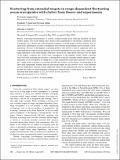Scattering from extended targets in range-dependent fluctuating ocean-waveguides with clutter from theory and experiments
Author(s)
Jagannathan, Srinivasan; Küsel, Elizabeth T.; Ratilal, Purnima; Makris, Nicholas
DownloadJASMAN1322680_1.pdf (1.350Mb)
PUBLISHER_POLICY
Publisher Policy
Article is made available in accordance with the publisher's policy and may be subject to US copyright law. Please refer to the publisher's site for terms of use.
Terms of use
Metadata
Show full item recordAbstract
Bistatic, long-range measurements of acoustic scattered returns from vertically extended, air-filled tubular targets were made during three distinct field experiments in fluctuating continental shelf waveguides. It is shown that SonarEquation estimates of mean target-scattered intensity lead to large errors, differing by an order of magnitude from both the measurements and waveguidescattering theory. The use of the Ingenito scatteringmodel is also shown to lead to significant errors in estimating mean target-scattered intensity in the field experiments because they were conducted in range-dependent ocean environments with large variations in sound speed structure over the depth of the targets, scenarios that violate basic assumptions of the Ingenito model. Green’s theorem based full-field modeling that describes scattering from vertically extended tubular targets in range-dependent oceanwaveguides by taking into account nonuniform sound speed structure over the target’s depth extent is shown to accurately describe the statistics of the targets’ scattered field in all three field experiments. Returns from the man-made targets are also shown to have a very different spectral dependence from the natural target-like clutter of the dominant fish schools observed, suggesting that judicious multi-frequency sensing may often provide a useful means of distinguishing fish from man-made targets.
Date issued
2012-08Department
Massachusetts Institute of Technology. Department of Earth, Atmospheric, and Planetary Sciences; Massachusetts Institute of Technology. Department of Mechanical EngineeringJournal
Journal of the Acoustical Society of America
Publisher
American Institute of Physics/Acoustical Society of America
Citation
Jagannathan, Srinivasan, Elizabeth T. Küsel, Purnima Ratilal, and Nicholas C. Makris. “Scattering from Extended Targets in Range-Dependent Fluctuating Ocean-Waveguides with Clutter from Theory and Experiments.” The Journal of the Acoustical Society of America 132, no. 2 (2012): 680. © 2012 Acoustical Society of America.
Version: Final published version
ISSN
00014966